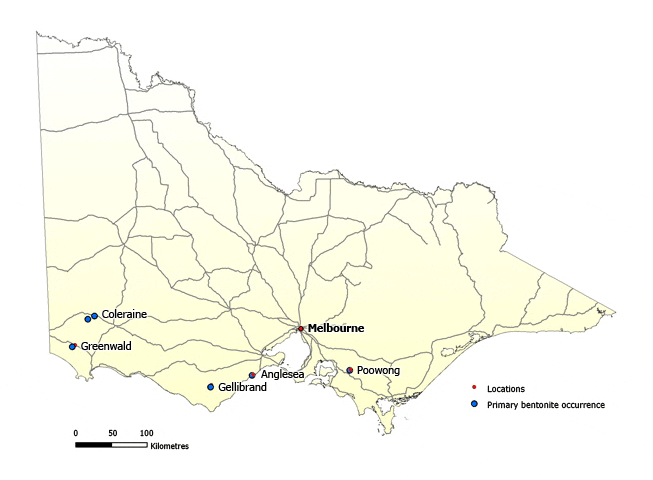Bentonite
Bentonite is a clay consisting mainly of smectite minerals, commonly formed by decomposition of volcanic ash or tuff, or sometimes from other igneous or sedimentary rocks. Bentonite is a very plastic clay that shrinks (or swells) markedly in response to the removal (or addition) of water.
There are three main types of bentonite:
- high swelling (sodium)
- low swelling (calcium)
- moderate swelling (intermediate sodium-calcium) bentonite.
The sodium bentonites are the most useful because of their greater swelling capacity. They are used mainly as bonding clay in foundries, in drilling mud, in animal feed pellets, and for civil engineering applications
Historically the majority of bentonite production in Victoria has been from the Greenwald deposit. The deposit consists of a layer of up to six metres thickness of calcium-rich bentonite that rests on limestone and is overlain by sandy clay and basalt. Most of the bentonite has been used in animal feed pellets.
The only other significant bentonite deposit is at Gellibrand, where there are a few impure bentonite seams interlayered with feldspathic sandstone, mudstone and shale.
There are minor bentonite occurrences at Soapy Rocks near Anglesea, at Poowong in South Gippsland, and near Coleraine.
There is potential for bentonite discoveries in the Murray Basin in northwestern Victoria. The host rocks are equivalent to those of the Arumpo deposit in southwest NSW.
View the full list of industrial minerals
Further information
Industrial minerals and rocks of Victoria – Geological Survey of Victoria Report 102
Maps
To create your own maps online and in real time, plan exploration activities by viewing land status, or download GIS data to add to your own maps, visit GeoVic.

Page last updated: 12 Jan 2023